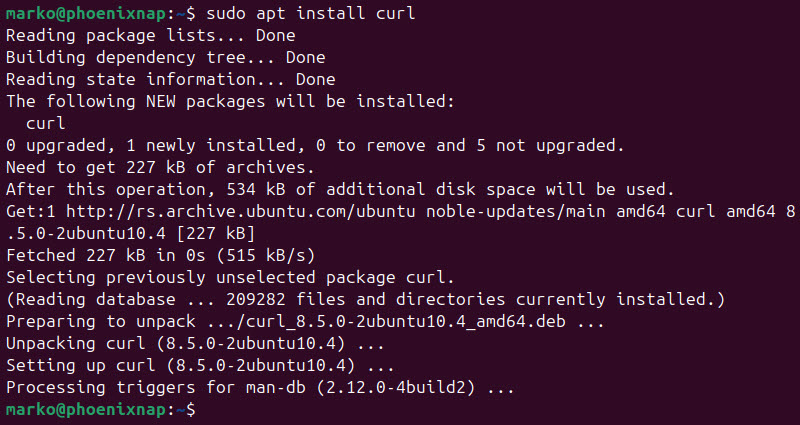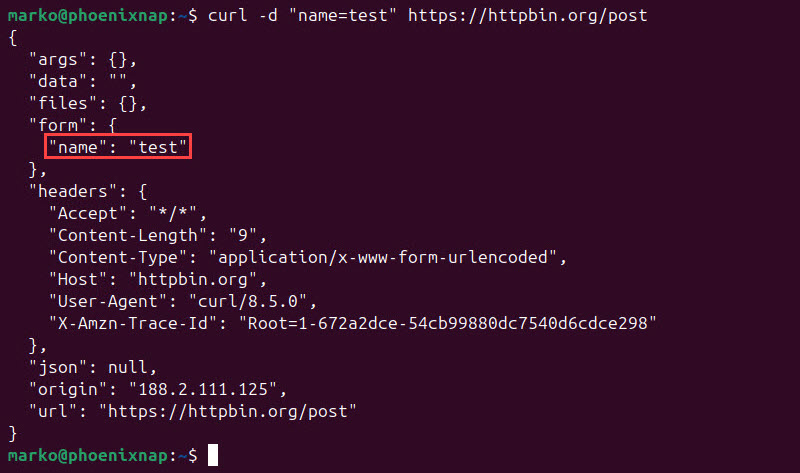Introduction
curl (short for Client URL) is a CLI tool that enables data transfer over various network protocols. It communicates with a web or application server by specifying a relevant URL and the data that needs to be sent or received.
This tutorial will show you how to use the curl command and provide an exhaustive list of the available options.

Prerequisites
- Command-line access.
- Administrative privileges on the system.
How to Install curl
The curl command is installed by default in many popular Linux distributions. If it is not present on the system, install it by entering the following command:
sudo apt install curlWait for the installation to finish.

How to Check curl Version
Confirm that curl is present on the system by checking the installed version. Use the curl command with the -V option:
curl -VThe output shows the versions of the main command and the relevant dependencies.

curl Syntax
curl is a robust, versatile tool that can be customized using various options. Below is the basic curl command syntax:
curl [options] [URLs]When the user provides a URL as an argument to curl, the command outputs the remote HTML content. For example, the following command shows the HTML code used for the gnu.html page on www.gnu.org:
curl https://www.gnu.org/gnu/gnu.html
If you specify a filename, you can use curl to download the content to a file on your local system:
curl [url] > [local-file]The progress bar shows how much of the file has been downloaded and other relevant information.

Multiple URLs that differ in one part are written together using braces:
http://example.{first,second,third}.comAlphanumeric series are written with brackets:
ftp://ftp.example.com/file[1-100].txtNested sequences are not supported, but multiple sequences are allowed:
http://example.com/archive[2010-2020]/vol[1-4]/part{a,b,c}.htmlcurl Options
The curl command options start with one or two dashes. The single-dash options can be written together if they do not require additional values. For example, the command that utilizes the -O, -L, and -v options can be written as:
curl -OLv [url]The list of all the available options is given below.
| Option | Description |
|---|---|
--abstract-unix-socket <path> | Connect through an abstract Unix socket instead of through a network. Example: curl --abstract-unix-socket /var/run/docker.sock http://localhost/images/json |
--alt-svc <parameters> | Enable alt-svc parser. Example: curl --alt-svc 'quic=":443"; ma=2592000; v="46,47,48"' https://example.com |
--anyauth | curl finds and uses the most secure authentication method for the given HTTP URL.Example: curl --anyauth --user user:password https://example.com |
-a, --append | Append to the target file. Example: curl --upload-file local --append ftp://example.com/ |
--aws-sigv4 <provider1[:provider2[:region[:service]]]> | Use AWS V4 signature authentication. Example: curl --aws-sigv4 "aws:amz:east-2:es" --user "key:secret" https://example.com |
--basic | Use HTTP basic authentication. Example: curl -u name:password --basic https://example.com |
--cacert <file> | Use the specified file for certificate verification. Example: curl --cacert CA-file.txt https://example.com |
--capath <dir> | Use the specified directory to look for the certificates. Example: curl --capath /local/directory https://example.com |
--cert-status | Send data to an HTTP server in a POST request. Example: curl -d "name=curl" https://example.com |
--cert-type <type> | Specify the type of the provided certificate. The recognized types are PEM (default), DER, ENG, and P12.Example: curl --cert-type ENG --cert file https://example.com |
-E, --cert <certificate[:password]> | Send data to an HTTP server in a POST request. Example: curl -d "name=curl" https://example.com |
--ciphers <list of ciphers> | Provide ciphers for the connection. Example: curl --ciphers ECDHE-ECDSA-AES256-CCM8 https://example.com |
--compressed-ssh | Enable built-in SSH compression. Example: curl --compressed-ssh sftp://example.com/ |
--compressed | Request to receive a compressed response. Example: curl --compressed https://example.com |
-K, --config <file> | Provide a text file with curl arguments instead of writing them on the command line. Example: curl --config file.txt https://example.com |
--connect-timeout <fractional seconds> | Specify the maximum time a curl connection may last.Example: curl --connect-timeout 30 https://example.com |
--connect-to <HOST1:PORT1:HOST2:PORT2> | Provide a connection rule to direct requests at a specific server cluster node. Example: curl --connect-to example.com:443:example.net:8443 https://example.com |
-C, --continue-at <offset> | Resume file transfer at the offset specified.curl -C 400 https://example.com |
-c, --cookie-jar <filename> | Specify a file for storing cookies.curl -c store.txt https://example.com |
-b, --cookie <data|filename> | Read cookies from a file. Example: curl -b cookiefile https://example.com |
--create-dirs | Create the local directories for the --output option. Example: curl --create-dirs --output local/dir/file https://example.com |
--create-file-mode <mode> | Specify which mode to set upon file creation. Example: curl --create-file-mode 0777 -T localfile sftp://example.com/new |
--crlf | Convert LF to CRLF. curl --crlf -T file ftp://example.com/ |
--crlfile <file> | Provide a Certificate Revocation List for peer certificates. curl --crlfile revoke.txt https://example.com |
--curves <algorithm list> | Provide curves for establishing an SSL session. Example: curl --curves X25519 https://example.com |
--data-ascii <data> | See -d, --data. Example: curl --data-ascii @file https://example.com |
--data-binary <data> | Post data as specified without extra processing. curl --data-binary @filename https://example.com |
--data-raw <data> | Same as -d, --data, but the (@) character is not treated differently from the rest. curl --data-raw "@at@at@" https://example.com |
--data-urlencode <data> | Same as -d, --data, but perform URL encoding.Example: curl --data-urlencode name=val https://example.com |
-d, --data <data> | Send data to a HTTP server in a POST request. Example: curl -d "name=curl" https://example.com |
--delegation <LEVEL> | Specify when the server is allowed to delegate credentials. Example: curl --delegation "always" https://example.com |
--digest | Enable HTTP Digest authentication. Example: curl -u name:password --digest https://example.com |
--disable-eprt | Disable EPRT and LPRT commands for active FTP transfers. Example: curl --disable-eprt ftp://example.com/ |
--disable-epsv | Disable EPSV for passive FTP transfers. Example: curl --disable-epsv ftp://example.com/ |
-q, --disable | Disable the reading of the curlrc config file.curl -q https://example.com |
--disallow-username-in-url | Disallow sending a URL that contains a username. Instead, send the credentials in the request header. Example: curl --disallow-username-in-url https://user:[email protected] |
--dns-interface <interface> | Specify an interface for outgoing DNS requests. Example: curl --dns-interface eth0 https://example.com |
--dns-ipv4-addr <address> | Specify the IPv4 address from which the DNS requests will come. Example: curl --dns-ipv4-addr 10.1.2.3 https://example.com |
--dns-ipv6-addr <address> | Specify an IPv6 address from which the DNS requests will come. Example: curl --dns-ipv6-addr 2a04:4e42::561 https://example.com |
--dns-servers <addresses> | Specify your list of DNS servers. Example: curl --dns-servers 192.168.0.1,192.168.0.2 https://example.com |
--doh-cert-status | --cert-status for DNS-over-HTTPS. Example: curl --doh-cert-status --doh-url https://doh.server https://example.com |
--doh-insecure | -k, --insecure for DoH.Example: curl --doh-insecure --doh-url https://doh.server https://example.com |
--doh-url <URL> | Specify a DoH server for hostname resolution. Example: curl --doh-url https://doh.server https://example.com |
-D, --dump-header <filename> | Specify a file for writing protocol headers. Example: curl --dump-header store.txt https://example.com |
--egd-file <file> | Provide a path for the EGD socket. Example: curl --egd-file /path/here https://example.com |
--engine <name> | Specify an OpenSSL crypto engine. Example: curl --engine flavor https://example.com |
--etag-compare <file> | Request an ETag read from a file. Example: curl --etag-compare etag.txt https://example.com |
--etag-save <file> | Save an HTTP ETag to a file. Example: curl --etag-save etag.txt https://example.com |
--expect100-timeout <seconds> | Maximum wait time for a 100-continue response. Example: curl --expect100-timeout 2.5 -T file https://example.com |
-f, --fail | If the server returns an error, curl fails silently and returns error 22. Example: curl --fail https://example.com |
-F, --form <name=content> | Emulate a form with a Submit button that has been pressed. The @ sign forces the content to be a file. The < sign extracts only the content part of the file. Example: curl --form "name=curl" --form "file=@loadthis" https://example.com |
--fail-early | Tell curl to fail and exit when it detects the first error in transfer. Example: curl --fail-early https://example.com |
--fail-with-body | If the server returns an error with code 400 or greater, curl saves the content and returns error 22. Example: curl --fail-with-body https://example.com |
--false-start | Use false start on TLS handshake. Example: curl --false-start https://example.com |
--form-string <name=string> | Similar to -F, --form, but the value strings are processed literally. Example: curl --form-string "data" https://example.com |
--ftp-account <data> | Specify the account data for the FTP server. Example: curl --ftp-account "account_data" ftp://example.com/ |
--ftp-alternative-to-user <command> | Specify the command to be sent if the username and password authentication fails. Example: curl --ftp-alternative-to-user "U53r" ftp://example.com |
--ftp-create-dirs | If the specified directory does not exist, curl will attempt to create it.Example: curl --ftp-create-dirs -T file ftp://example.com/dirs/one/file |
--ftp-method <method> | Specify a method to be used to obtain files over FTP. Available methods are multicwd, nocwd, and singlecwd. Example: curl --ftp-method multicwd ftp://example.com/dir1/dir2/file |
--ftp-pasv | Use passive data connection mode. Example: curl --ftp-pasv ftp://example.com/ |
-P, --ftp-port <address> | Reverse the default roles for the FTP connection. Example: curl -P eth0 ftp:/example.com |
--ftp-pret | Send the PRET command before PASV/EPSV. Example: curl --ftp-pret ftp://example.com/ |
--ftp-skip-pasv-ip | Do not use the IP address suggested by the server. curl will use the control connection IP. Example: curl --ftp-skip-pasv-ip ftp://example.com/ |
--ftp-ssl-ccc-mode <active/passive> | Set the Clear Command Channel (CCC) mode. Example: curl --ftp-ssl-ccc-mode active --ftp-ssl-ccc ftps://example.com/ |
--ftp-ssl-ccc | The SSL/TLS layer is eliminated after the authentication, allowing unencrypted communication. Example: curl --ftp-ssl-ccc ftps://example.com/ |
--ftp-ssl-control | Use SSL/TLS for logging in and stop the encryption when the data transfer starts. Example: curl --ftp-ssl-control ftp://example.com |
-G, --get | Use HTTP GET request instead of POST. Example: curl --get -d "tool=curl" -d "age=old" https://example.com |
-g, --globoff | Disable the URL globbing parser. Example: curl -g "https://example.com/{[]}}}}" |
--happy-eyeballs-timeout-ms <milliseconds> | Use the Happy Eyeballs algorithm to connect to dual-stack hosts. Example: curl --happy-eyeballs-timeout-ms 500 https://example.com |
--haproxy-protocol | Use HAProxy PROXY protocol v1 header. Example: curl --haproxy-protocol https://example.com |
-I, --head | Obtain only headers. Example: curl -I https://example.com |
-H, --header <header/@file> | Specify an additional header to be sent in the HTTP request. Example: curl -H "X-First-Name: Joe" https://example.com |
-h, --help <category> | See help for a specific category. all lists all the available options. Example: curl --help all |
--hostpubmd5 <md5> | Pass a 32-digit hexadecimal string. Example: curl --hostpubmd5 e5c1c49020640a5ab0f2034854c321a8 sftp://example.com/ |
--hsts <file name> | Enable HSTS. Example: curl --hsts cache.txt https://example.com |
--http0.9 | Accept an HTTP version 0.9 response. Example: curl --http0.9 https://example.com |
-0, --http1.0 | Use HTTP version 1.0. Example: curl --http1.0 https://example.com |
--http1.1 | Use HTTP version 1.1. Example: curl --http1.1 https://example.com |
--http2-prior-knowledge | Use HTTP version 2.0. Use this option if you know that the server supports this HTTP version. Example: curl --http2-prior-knowledge https://example.com |
--http2 | Attempt to use HTTP version 2.0. Example: curl --http2 https://example.com |
--http3 | Use HTTP version 3.0. This is an experimental option. Example: curl --http3 https://example.com |
--ignore-content-length | Ignore the Content-Length header. Example: curl --ignore-content-length https://example.com |
-i, --include | Specify that the output should include the HTTP response headers. Example: curl -i https://example.com |
-k, --insecure | Allow curl to work with insecure connections. Example: curl --insecure https://example.com |
--interface <name> | Specify the interface for performing an action. Example: curl --interface eth0 https://example.com |
-4, --ipv4 | Only resolve names to IPv4 addresses. Example: curl --ipv4 https://example.com |
-6, --ipv6 | Only resolve names to IPv6 addresses. Example: curl --ipv6 https://example.com |
-j, --junk-session-cookies | Discard session cookies. Example: curl --junk-session-cookies -b cookies.txt https://example.com |
--keepalive-time <seconds> | Specify the idle time for the connection before it sends keepalive probes. Example: curl --keepalive-time 30 https://example.com |
--key-type <type> | Specify the type of the private key. Available types are PEM (default), DER, and ENG. Example: curl --key-type ENG --key here https://example.com |
--key <key> | Specify the file containing the private key. Example: curl --cert certificate --key here https://example.com |
--krb <level> | Enable and use Kerberos authentication. Available levels are clear, safe, confidential, and private (default). Example: curl --krb clear ftp://example.com/ |
--libcurl <file> | Obtain C source code for the specified command line operation. Example: curl --libcurl client.c https://example.com |
--limit-rate <speed> | Specify the maximum upload and download transfer rate. Example: curl --limit-rate 100K https://example.com |
-l, --list-only | Force a name-only view. Example: curl --list-only ftp://example.com/dir/ |
--local-port <num/range> | Specify the port numbers to be used for the connection. Example: curl --local-port 1000-3000 https://example.com |
--location-trusted | Similar to -L, --location, but enables you to send a name and password to all redirections.Example: curl --location-trusted -u user:pass https://example.com |
-L, --location | Allow curl to follow any redirections. Example: curl -L https://example.com |
--login-options <options> | Specify the login options for email server authentication. Example: curl --login-options 'AUTH=*' imap://example.com |
--mail-auth <address> | Provide a single address as the identity. Example: curl --mail-auth [email protected] -T mail smtp://example.com/ |
--mail-from <address> | Provide a single from address. Example: curl --mail-from [email protected] -T mail smtp://example.com/ |
--mail-rcpt-allowfails | Allows curl to continue with the SMTP conversation if one of the recipients fails. Example: curl --mail-rcpt-allowfails --mail-rcpt [email protected] smtp://example.com |
--mail-rcpt <address> | Provide a single to address. Example: curl --mail-rcpt [email protected] smtp://example.com |
-M, --manual | Read the curl manual. Example: curl --manual |
--max-filesize <bytes> | Provide the maximum size of the file to be downloaded. Example: curl --max-filesize 500K https://example.com |
--max-redirs <num> | Specify the maximum number of redirections when --location is active. Example: curl --max-redirs 3 --location https://example.com |
-m, --max-time <fractional seconds> | Specify the maximum time for an operation. Example: curl --max-time 5.52 https://example.com |
--metalink | Specify a metalink resource. This option is disabled in the newest versions of curl. Example: curl --metalink file https://example.com |
-n, --netrc | Search the netrc file for login information. Example: curl --netrc https://example.com |
-N, --no-buffer | Disable output stream buffer. Example: curl --no-buffer https://example.com |
--negotiate | Enable SPNEGO authentication. Example: curl --negotiate -u : https://example.com |
--netrc-file <filename> | Like --n, --netrc, but allows you to specify the file to be used. Example: curl --netrc-file netrc https://example.com |
--netrc-optional | Like --n, --netrc, but using netrc is optional. Example: curl --netrc-optional https://example.com |
-:, --next | Use the option to separate URL requests. Example: curl -I https://example.com --next https://example.net/ |
--no-alpn | Disable ALPN TLS extension. Example: curl --no-alpn https://example.com |
--no-keepalive | Disable keepalive messages. Example: curl --no-keepalive https://example.com |
--no-npn | Disable NPN TLS extension. Example: curl --no-npn https://example.com |
--no-progress-meter | Disable the progress bar but display any other message. Example: curl --no-progress-meter -o store https://example.com |
--no-sessionid | Disable the caching of SSL session-ID. Example: curl --no-sessionid https://example.com |
--noproxy <no-proxy-list> | List the hosts that should not use a proxy. Example: curl --noproxy "www.example" https://example.com |
--ntlm | Enable NTLM authentication. Example: curl --ntlm -u user:password https://example.com |
--ntlm-wb | Like --ntlm, but also hands authentication to ntlmauth.Example: curl --ntlm-wb -u user:password https://example.com |
-o, --output <file> | Store output in a file. The output is not shown in stdout. Example: curl -o file https://example.com -o file2 https://example.net |
--oauth2-bearer <token> | Provide a Bearer Token for OAUTH 2.0. Example: curl --oauth2-bearer "mF_9.B5f-4.1JqM" https://example.com |
--output-dir <dir> | Specify the output file directory. Example: curl --output-dir "tmp" -O https://example.com |
--parallel-immediate | Prefer parallel connections to waiting for new connections or multiplexed streams. Example: curl --parallel-immediate -Z https://example.com -o file1 https://example.com -o file2 |
--parallel-max <num> | Specify the maximum number of parallel connections. Example: curl --parallel-max 100 -Z https://example.com ftp://example.com/ |
-Z, --parallel | Perform transfers in parallel. Example: curl --parallel https://example.com -o file1 https://example.com -o file2 |
--pass <phrase> | Specify a private key passphrase. Example: curl --pass secret --key file https://example.com |
--path-as-is | Prevent curl from merging /./ and /../ sequences. Example: curl --path-as-is https://example.com/../../etc/passwd |
--pinnedpubkey <hashes> | Specify a public key for curl to use. Example: curl --pinnedpubkey keyfile https://example.com |
--post301 | Prevent curl from converting POST to GET requests after a 301 redirection. Example: curl --post301 --location -d "data" https://example.com |
--post302 | Prevent curl from converting POST to GET requests after a 302 redirection. curl --post302 --location -d "data" https://example.com |
--post303 | Prevent curl from converting POST to GET requests after a 303 redirection. Example: curl --post303 --location -d "data" https://example.com |
--preproxy [protocol://]host[:port] | Use the SOCKS proxy as a pre-proxy. Example: curl --preproxy socks5://proxy.example -x http://http.example https://example.com |
-#, --progress-bar | Use the simple progress bar. Example: curl -# -O https://example.com |
--proto-default <protocol> | Specify which protocol curl should use for URLs without a scheme name. Example: curl --proto-default https ftp.example.com |
--proto-redir <protocols> | Specify which protocols curl should use on redirection. Example: curl --proto-redir =http,https https://example.com |
--proto <protocols> | Specify which protocols curl should use for transfers. Example: curl --proto =http,https,sftp https://example.com |
--proxy-anyauth | curl should choose an appropriate authentication method. Example: curl --proxy-anyauth --proxy-user user:passwd -x proxy https://example.com |
--proxy-basic | Use HTTP Basic to communicate with a proxy. Example: curl --proxy-basic --proxy-user user:passwd -x proxy https://example.com |
--proxy-cacert <file> | --cacert for HTTPS proxies. Example: curl --proxy-cacert CA-file.txt -x https://proxy https://example.com |
--proxy-capath <dir> | --capath for HTTPS proxies. Example: curl --proxy-capath /local/directory -x https://proxy https://example.com |
--proxy-cert-type <type> | --cert-type for HTTPS proxies. Example: curl --proxy-cert-type PEM --proxy-cert file -x https://proxy https://example.com |
--proxy-cert <cert[:passwd]> | -E, --cert for HTTPS proxies. Example: curl --proxy-cert file -x https://proxy https://example.com |
--proxy-ciphers <list> | --ciphers for HTTPS proxies. curl --proxy-ciphers ECDHE-ECDSA-AES256-CCM8 -x https://proxy https://example.com |
--proxy-crlfile <file> | --crlfile for HTTPS proxies. Example: curl --proxy-crlfile rejects.txt -x https://proxy https://example.com |
--proxy-digest | Use HTTP Digest authentication with a proxy. Example: curl --proxy-digest --proxy-user user:passwd -x proxy https://example.com |
--proxy-header <header/@file> | -H, --header for proxy communication. Example: curl --proxy-header "Host:" -x http://proxy https://example.com |
--proxy-insecure | -k, --insecure for HTTPS proxies. Example: curl --proxy-insecure -x https://proxy https://example.com |
--proxy-key-type <type> | --key-type for HTTPS proxies. Example: curl --proxy-key-type DER --proxy-key here -x https://proxy https://example.com |
--proxy-key <key> | --key for HTTPS proxies. Example: curl --proxy-key here -x https://proxy https://example.com |
--proxy-negotiate | --negotiate for proxy communication.Example: curl --proxy-negotiate --proxy-user user:passwd -x proxy https://example.com |
--proxy-ntlm | Use HTTP NTLM authentication with a proxy. Example: curl --proxy-ntlm --proxy-user user:passwd -x http://proxy https://example.com |
--proxy-pass <phrase> | --pass for HTTPS proxies. Example: curl --proxy-pass secret --proxy-key here -x https://proxy https://example.com |
--proxy-pinnedpubkey <hashes> | Specify the public key for proxy verification. Example: curl --proxy-pinnedpubkey keyfile https://example.com |
--proxy-service-name <name> | Specify the service name for proxy communication. Example: curl --proxy-service-name "shrubbery" -x proxy https://example.com |
--proxy-ssl-allow-beast | --ssl-allow-beast for HTTPS proxies. Example: curl --proxy-ssl-allow-beast -x https://proxy https://example.com |
--proxy-ssl-auto-client-cert | --ssl-auto-client-cert for HTTPS proxies. Example: curl --proxy-ssl-auto-client-cert -x https://proxy https://example.com |
--proxy-tls13-ciphers <ciphersuite list> | Specifies the list of cipher suites to negotiate TLS 1.3 for proxies. Example: curl --proxy-tls13-ciphers TLS_AES_128_GCM_SHA256 -x proxy https://example.com |
--proxy-tlsauthtype <type> | --tlsauthtype for HTTPS proxies. Example: curl --proxy-tlsauthtype SRP -x https://proxy https://example.com |
--proxy-tlspassword <string> | --tlspassword for HTTPS proxies.Example: curl --proxy-tlspassword passwd -x https://proxy https://example.com |
--proxy-tlsuser <name> | --tlsuser for HTTPS proxies. Example: curl --proxy-tlsuser smith -x https://proxy https://example.com |
--proxy-tlsv1 | -1, --tlsv1 for HTTPS proxies. Example: curl --proxy-tlsv1 -x https://proxy https://example.com |
-U, --proxy-user <user:password> | Specify the username and password for authenticating with a proxy. Example: curl --proxy-user name:pwd -x proxy https://example.com |
-x, --proxy [protocol://]host[:port] | Specify a proxy to use. Example: curl --proxy http://proxy.example https://example.com |
--proxy1.0 <host[:port]> | Specify an HTTP 1.0 proxy to use. Example: curl --proxy1.0 -x http://proxy https://example.com |
-p, --proxytunnel | Create a proxy tunnel. Example: curl --proxytunnel -x http://proxy https://example.com |
--pubkey <key> | Provide a file containing a public key. Example: curl --pubkey file.pub sftp://example.com/ |
-Q, --quote <command> | Send a command to an FTP or SFTP server to be executed before the transfer. Example: curl --quote "rm file" ftp://example.com/foo |
--random-file <file> | Specify a file containing random data. This file will be used for seeding the random engine. Example: curl --random-file rubbish https://example.com |
-r, --range <range> | Obtain a range of bytes. Example: curl --range 40-80 https://example.com |
--raw | Disable HTTP content decoding and obtain raw data. Example: curl --raw https://example.com |
-e, --referer <URL> | Send Referrer Page information. Example: curl --referer "https://test.example" https://example.com |
-J, --remote-header-name | Use the header name specified by the server instead of obtaining it from the URL. Example: curl -OJ https://example.com/file |
-O, --remote-name | Specify that the local file should have the name of the remote file that was downloaded. Example: curl -O https://example.com/filename |
--remote-name-all | Apply the -O, --remote-name option to all the URLs.Example: curl --remote-name-all ftp://example.com/file1 ftp://example.com/file2 |
-R, --remote-time | Specify that the local file should have the timestamp of the remote file that was downloaded. Example: curl --remote-time -o foo https://example.com |
--request-target <path> | Specify an alternative target path. Example: curl --request-target "*" -X OPTIONS https://example.com |
-X, --request <command> | Specify a request method for communication with the server. Example: curl -X "DELETE" https://example.com |
--resolve <[+]host:port:addr[,addr]...> | Specify a custom address for a host/port. Example: curl --resolve example.com:443:127.0.0.1 https://example.com |
--retry-all-errors | Force retrying on all errors. Example: curl --retry-all-errors https://example.com |
--retry-connrefused | Add ECONNREFUSED to the list of errors that are eligible for --retry. Example: curl --retry-connrefused --retry https://example.com |
--retry-delay <seconds> | Specify the amount of time between retries. Example: curl --retry-delay 5 --retry https://example.com |
--retry-max-time <seconds> | Specify the maximum amount of time for --retry attempts. Example: curl --retry-max-time 30 --retry 10 https://example.com |
--retry <num> | Specify the number of retries after curl encounters an error. Example: curl --retry 7 https://example.com |
--sasl-authzid <identity> | Specify an additional authentication identity for SASL PLAIN authentication. Example: curl --sasl-authzid zid imap://example.com/ |
--sasl-ir | Enable initial response during SASL authentication. Example: curl --sasl-ir imap://example.com/ |
--service-name <name> | Specify the SPNEGO service name. Example: curl --service-name sockd/server https://example.com |
-s, --silent | Turn on the silent mode. This option mutes curl.Example: curl -s https://example.com |
-S, --show-error | Show an error message event with the -s, --silent option enabled. Example: curl --show-error --silent https://example.com |
--socks4 <host[:port]> | Specify a SOCKS4 proxy. Example: curl --socks4 hostname:4096 https://example.com |
--socks4a <host[:port]> | Specify a SOCKS4a proxy. Example: curl --socks4a hostname:4096 https://example.com |
--socks5-basic | Use the basic authentication method (username/password) with a SOCKS5 proxy. Example: curl --socks5-basic --socks5 hostname:4096 https://example.com |
--socks5-gssapi-nec | Allow protection mode negotiation to be unprotected. Example: curl --socks5-gssapi-nec --socks5 hostname:4096 https://example.com |
--socks5-gssapi-service <name> | Change the name of a socks server. Example: curl --socks5-gssapi-service sockd --socks5 hostname:4096 https://example.com |
--socks5-gssapi | Use GSS-API authentication with a SOCKS5 proxy. Example: curl --socks5-gssapi --socks5 hostname:4096 https://example.com |
--socks5-hostname <host[:port]> | Specify the SOCKS5 proxy to use. Example: curl --socks5-hostname proxy.example:7000 https://example.com |
--socks5 <host[:port]> | Specify the SOCKS5 proxy to use. The hostname is resolved locally. Example: curl --socks5 proxy.example:7000 https://example.com |
-Y, --speed-limit <speed> | Set the lower limit for the download speed. Example: curl --speed-limit 300 --speed-time 10 https://example.com |
-y, --speed-time <seconds> | Set the time period for the speed limit measurement. Example: curl --speed-limit 300 --speed-time 10 https://example.com |
--ssl-allow-beast | Tell curl to ignore the BEAST security flaw in the SSL3 and TLS1.0 protocols. Example: curl --ssl-allow-beast https://example.com |
--ssl-auto-client-cert | Obtain and use a client certificate automatically. Example: curl --ssl-auto-client-cert https://example.com |
--ssl-no-revoke | Do not check for certificate revocation. Example: curl --ssl-no-revoke https://example.com |
--ssl-reqd | Require SSL/TLS. Example: curl --ssl-reqd ftp://example.com |
--ssl-revoke-best-effort | Ignore certificate revocation checks if they fail because of missing distribution points. Example: curl --ssl-revoke-best-effort https://example.com |
--ssl | Attempt to use SSL. Example: curl --ssl pop3://example.com/ |
-2, --sslv2 | Use SSLv2. Newer curl versions ignore this request due to security concerns with SSLv2.Example: curl --sslv2 https://example.com |
-3, --sslv3 | Use SSLv3. Newer curl versions ignore this request due to security concerns with SSLv3. Example: curl --sslv3 https://example.com |
--stderr <file> | Output stderr to a file. The (-) symbol tells curl to output stderr to stdout. Example: curl --stderr output.txt https://example.com |
--styled-output | Enable bold fonts for HTTP header terminal output. curl --styled-output -I https://example.com |
--suppress-connect-headers | Prevent curl from outputting CONNECT headers. Example: curl --suppress-connect-headers --include -x proxy https://example.com |
--tcp-fastopen | Enable TCP Fast Open. Example: curl --tcp-fastopen https://example.com |
--tcp-nodelay | Enable TCP_NODELAY. Example: curl --tcp-nodelay https://example.com |
-t, --telnet-option <opt=val> | Pass the TTYPE, XDISPLOC, and NEW_ENV options to the telnet protocol. Example: curl -t TTYPE=vt100 telnet://example.com/ |
--tftp-blksize <value> | Set the value of TFTP BLKSIZE. Must be a value larger than 512. Example: curl --tftp-blksize 1024 tftp://example.com/file |
--tftp-no-options | Prevents curl from sending requests for TFTP options.Example: curl --tftp-no-options tftp://192.168.0.1/ |
-z, --time-cond <time> | Request a document that was modified after a certain date and time. For documents modified before the time, prefix the date expression with a dash. Example: curl -z "Wed 01 Sep 2021 12:18:00" https://example.com |
--tls-max <VERSION> | Specify the newest supported TLS version. Example: curl --tls-max 1.2 https://example.com |
--tls13-ciphers <ciphersuite list> | Specifies the list of cipher suites to use in negotiating TLS 1.3 Example: curl --tls13-ciphers TLS_AES_128_GCM_SHA256 https://example.com |
--tlsauthtype <type> | Specify the TLS authentication type. Example: curl --tlsauthtype SRP https://example.com |
--tlspassword <string> | Specify the TLS password. Example: curl --tlspassword pwd --tlsuser user https://example.com |
--tlsuser <name> | Specify the TLS username. Example: curl --tlspassword pwd --tlsuser user https://example.com |
--tlsv1.0 | Tell curl to use TLS 1.0 or newer. Example: curl --tlsv1.0 https://example.com |
--tlsv1.1 | Tell curl to use TLS 1.1 or newer. Example: curl --tlsv1.1 https://example.com |
--tlsv1.2 | Tell curl to use TLS 1.2 or newer. Example: curl --tlsv1.2 https://example.com |
--tlsv1.3 | Tell curl to use TLS1.3 or newer. Example: curl --tlsv1.3 https://example.com |
-1, --tlsv1 | Specify that curl should use at least 1.x version of TLS.Example: curl --tlsv1 https://example.com |
--tr-encoding | Ask for a compressed Transfer-Encoding response. Example: curl --tr-encoding https://example.com |
--trace-ascii <file> | Enable a full trace dump to a file. Eliminates the hex part and shows only ASCII. Example: curl --trace-ascii log.txt https://example.com |
--trace-time | Require a time stamp on each trace or verbose line. Example: curl --trace-time --trace-ascii output https://example.com |
--trace <file> | Enable a full trace dump to a file. Example: curl --trace log.txt https://example.com |
--unix-socket <path> | Specify a Unix socket path. Example: curl --unix-socket socket-path https://example.com |
-T, --upload-file <file> | Upload a file to the URL. Example: curl -T "img[1-1000].png" ftp://ftp.example.com/ |
--url <url> | Provide a URL to be fetched. Example: curl --url https://example.com |
-B, --use-ascii | Enable ASCII transfer. Example: curl -B ftp://example.com/README |
-A, --user-agent <name> | Specify the user agent name. Example: curl -A "Agent 007" https://example.com |
-u, --user <user:password> | Provide the username and password for authentication. Example: curl -u user:secret https://example.com |
-v, --verbose | Tell curl to be verbose. Example: curl --verbose https://example.com |
-V, --version | See the installed versions of curl and libcurl.Example: curl --version |
-w, --write-out <format> | Tell curl to show information about the completed transfer on stdout. Example: curl -w '%{http_code}\n' https://example.com |
--xattr | Store file metadata in file attributes. Example: curl --xattr -o storage https://example.com |
For comprehensive descriptions of the options, execute the curl --manual command in the terminal.
Note: Learn what rate limiting is and how it can be used to protect your server from malicious attacks.
curl Protocols
curl supports numerous protocols for data transfer. Find the complete list below.
| Protocol | Description |
|---|---|
| DICT | A dictionary network protocol for querying dictionary servers about the meanings of words. |
| FILE | A URL scheme for obtaining a file from the local file system using curl. |
| FTP, FTPS | File Transfer Protocol, used for file transfers between clients and servers. FTPS is the version of the same protocol with an added SSL/TLS security layer. |
| GOPHER, GOPHERS | An old protocol for searching, retrieving, and distributing internet documents, a precursor of HTTP. GOPHERS is the version of the same protocol with an added SSL/TLS security layer. |
| HTTP, HTTPS | Hypertext Transfer Protocol used for web and internet data transfer. HTTPS is the version of the same protocol with an added SSL/TLS security layer. |
| IMAP, IMAPS | Internet Message Access Protocol used for email access and management. IMAPS is the version of the same protocol with an added SSL/TLS security layer. |
| LDAP, LDAPS | Lightweight Directory Access Protocol used for distributed directory information access and management. LDAPS is the version of the same protocol with an added SSL/TLS security layer. |
| MQTT | Message Queuing Telemetry Transport, a protocol for data exchange between small devices, usually IoT systems. |
| POP3, POP3S | Post Office Protocol version 3, a protocol for email retrieval from a server. POP3S is the version of the same protocol with an added SSL/TLS security layer. |
| RTMP | Real-Time Messaging Protocol, a streaming protocol for audio, video, and other data. |
| RTSP | Real-Time Streaming Protocol used to manage streaming media servers. |
| SCP | Secure Copy, a protocol for copying files to and from an SSH server. |
| SFTP | SSH File Transfer Protocol, a version of the File Transfer Protocol using the SSH connection. |
| SMB, SMBS | Server Message Block, a protocol for managing shared access to files and computer peripherals. SMBS is the version of the same protocol with an added SSL/TLS security layer. |
| SMTP, SMPTS | Simple Mail Transfer Protocol, an email protocol for easy transmission of email. SMTPS is the version of the same protocol with an added SSL/TLS security layer. |
| TELNET | An application layer protocol for bidirectional interactive text-oriented communication. |
| TFTP | Trivial File Transfer Protocol, used for uploading or downloading files to or from a remote host. |
How to Use curl: Examples
curl is powered by libcurl, a portable client-side URL transfer library. You can use it directly in the command line or include it in a script. The most common use cases for curl are:
- Downloading files from the internet.
- Endpoint testing.
- Debugging.
- Error logging.
The following sections provide examples of some of the frequently issued curl commands.
Downloading Files
The most frequent usage scenario for curl is downloading files from remote servers. For example, the following command downloads a file named Lumia_1520.jpg from a demo website:
curl -O http://www.demoblaze.com/imgs/Lumia_1520.jpgThe -O option tells curl to save the file with its original file name.

To change the filename, use the -o option. The command below saves the file as image.jpg:
curl -o image.jpg https://www.demoblaze.com/imgs/Lumia_1520.jpg
Listing the contents of the directory with the ls command shows the two downloaded files:
ls
Configuring Connection Timeout
A non-existent resource on a remote server can cause curl to hang, which can be a problem in scripting. The --connection-timeout option assigns a time interval for executing the command before it fails.
For example, the following command attempts to download a file named file1.txt from the example.com website.
curl --connect-timeout 10 ftp://example.com/file1.txtThe file does not exist on the server, so the command hangs. After 10 seconds configured via --connect-timeout, the connection drops, freeing the terminal prompt.

Sending POST Request
When executed without options, the curl command sends a GET request to the server. However, sending other HTTP requests is also possible. The example below uses the -d option to send a POST request with the value name=test to a test website.
curl -d "name=test" https://httpbin.org/postThe output shows that the server successfully received the POST request.

Uploading and Downloading via FTP
Use curl to upload and download files via FTP. The example below uploads image.jpg to a test website:
curl -T "image.jpg" -u dlpuser:rNrKYTX9g7z3RgJRmxWuGHbeu ftp://ftp.dlptest.comThe -T option accepts a filename, while -u allows the user to provide access credentials.

Downloading is performed by providing the address of the remote file. In the following example, the file is locally saved as image_download.jpg using the -o option:
curl -u dlpuser:rNrKYTX9g7z3RgJRmxWuGHbeu ftp://ftp.dlptest.com/image.jpg -o image_download.jpg
Conclusion
After reading this tutorial, you should know how to use the curl command and its numerous options. The article also offered examples of common usage of the command.
To find out more about what curl can do, read how to Set or Change User Agent with curl.


